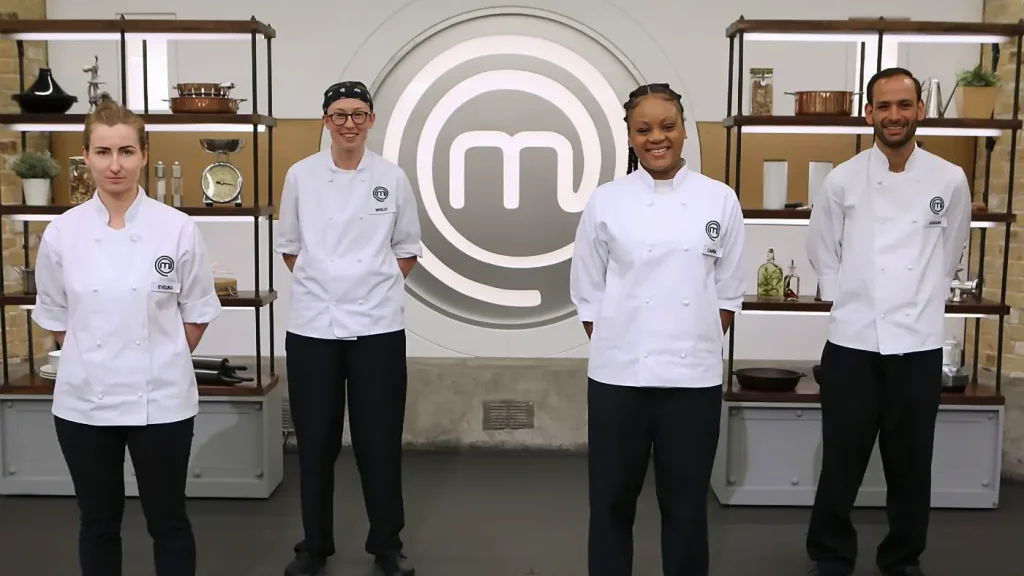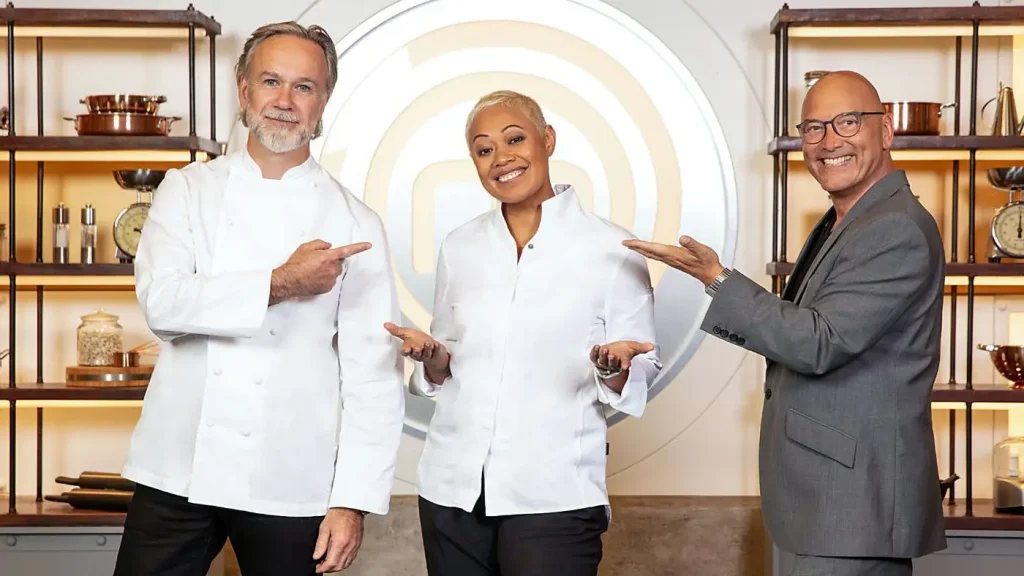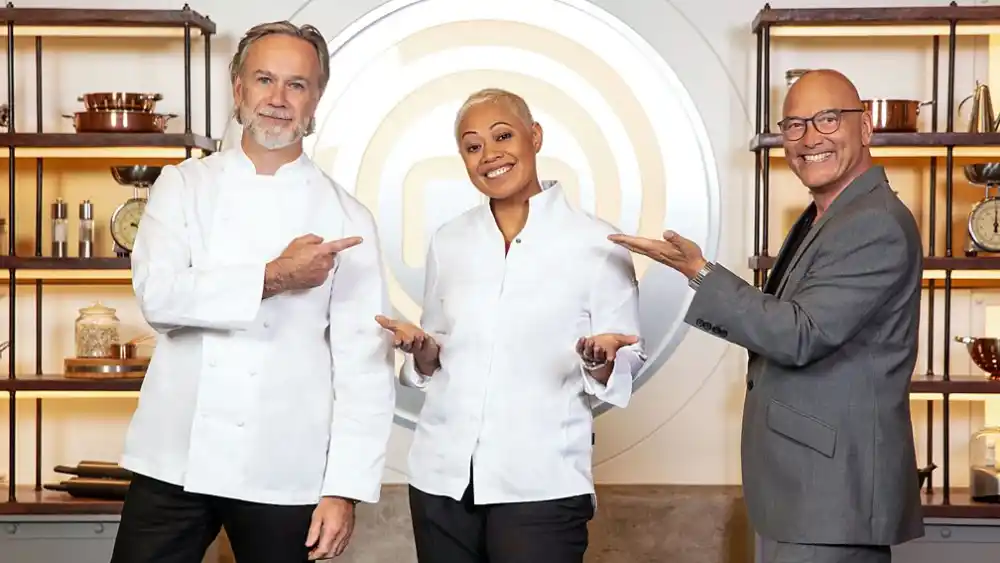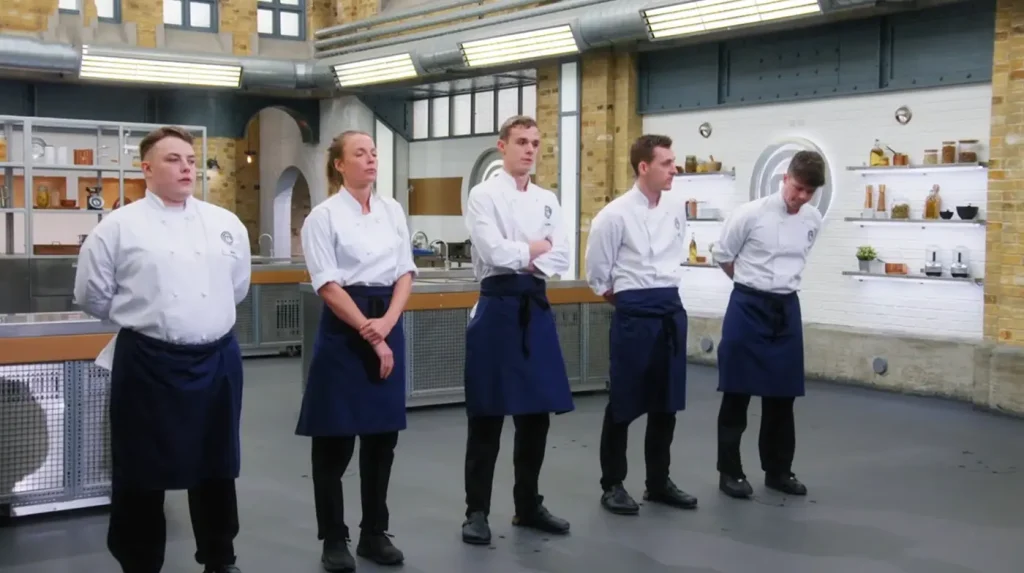MasterChef: The Professionals 2023 episode 5 – In this week’s exhilarating second heat, a fresh set of four culinary hopefuls takes center stage, eager to showcase their prowess to the esteemed trio of judges: Monica, Marcus, and Gregg. These aspiring chefs are not only driven by their passion but are also fueled by the ambition to reach the zenith of the culinary world. Yet, amidst the fierce competition, only the two most outstanding chefs will earn the privilege to advance to the much-anticipated quarter-final round, set to unfold at the week’s culmination.
Initiating the intense showdown is the notoriously demanding Skills Test. This segment, renowned for its ability to unnerve even the most seasoned chefs, sets the tone for the competition. The initial pair of chefs faces a meticulous challenge orchestrated by Monica. Their assignment? To masterfully prepare and cook succulent scallops, ensuring they are perfectly seared. But that’s just the beginning. They must then pair these scallops with a delicately prepared bed of carrots and a uniquely textured peanut sauce that complements the dish’s flavors.
On the other side, the subsequent pair of chefs is entrusted with a task set by Marcus, one that requires a deep understanding of flavors and textures. Drawing inspiration from the timeless poire belle Helene, they are to encapsulate the essence of lusciously poached pears, rich chocolate, and airy Chantilly cream. The twist? They must ingeniously present these flavors alongside meticulously layered pastry, ensuring each layer tells a story of its own.
However, the competition’s tempo doesn’t relent. The second segment grants all four culinary artists a golden opportunity to leave the pressures of the Skills Test in the past and truly shine. They are presented with the challenge to design their very own Signature Menu. With a generous one hour and 30 minutes on the clock, they must pour their heart and soul into their creations. This is their moment to flaunt their distinct style, impeccable technique, and keen eye for aesthetic plating. The goal? To craft a dish so remarkable, it unequivocally secures them a coveted spot in the quarter-finals.
MasterChef: The Professionals 2023 Episode 5 – Technical Precision and Artistic Flair

Four driven chefs enter the legendary MasterChef kitchen in the next heat, eager to prove their skills and creativity worthy of advancing to the quarter-final. To impress judges Monica Galetti, Marcus Wareing and Gregg Wallace, they must first survive the dreaded Skills Test by executing two intense culinary challenges under extreme time pressure. Those still standing will then have one chance left to dazzle with their imaginative Signature Menu. Only the top two will move forward in the competition.
Fundamentals Are Non-Negotiable for MasterChef Caliber Chefs
There are no excuses for sloppy knife work, underseasoned food or drab plating when cooking at a professional level. The Skills Test exposes weaknesses in core techniques by eliminating any room for fundamental errors. With reputations at stake, the judges expect flawless execution.
Proper seasoning and temperature control ensure proteins are perfectly cooked. Careful knife handling maintains uniform sizes and avoids ragged cuts. Keeping the cooking area organized and clean displays professionalism. And elegant plating requires an artistic eye for color, shape and balance.
Attention to detail is mandatory, like drying scallops well before searing or encasing pastry layers in butter for flakiness. Rushing causes obvious mistakes that ruin dishes. MasterChef demands technical excellence, not approximations. Only chefs who master fundamentals will withstand the judges’ scrutiny.
Creativity Shines in the Signature Menu Challenge
With basics proven in the Skills Test, the cooks still standing display their true colors and creativity through the Signature Menu. Developing an original concept and executing it under intense pressure separates rising stars from one-hit wonders. This challenge crowns champions.
Each menu must tell a culinary story reflecting the chef’s unique point of view and identity. Dishes should harmonize on one cohesive theme, not feel disjointed. Points are awarded for imagination, balance of flavors and elegant plating.
Technique remains vital as cooks juggle numerous components. Poaching pears in red wine while searing duck breast requires precision. But the memorability stems from creativity, like wowing with an ingenious carrot fluid gel garnish.
This is the moment for the chefs to remove all limits and dream big. Molecular gastronomy, exotic spices and novel plating strategies all come into play. Dishes must look worthy of fine dining photographs. Normal food simply will not suffice to win MasterChef.
The most imaginative chef with vision and skills to match who can synthesize creative concepts into technically sound dishes will have the edge. Their passion for innovation and excellence will shine through to earn a place in the quarter-final.
Time Management Is Paramount
With only 90 minutes to deliver two refined courses, time management errors guarantee catastrophe. The chefs must use their preparation time wisely to organize ingredients, begin long-cooking items and finely prep all produce. Scrambling once the timer starts means something will be undercooked, overseasoned or sloppily plated.
A clearly written prep list with every needed ingredient, tool and step is essential. Checking items off as they are prepared provides confidence everything is ready. Once cooking commences, laser focus on each timed element prevents coordination breakdowns.
Particularly for intricate tasks like rolling out phyllo dough or layering components into a terrine, the chefs must allow sufficient time. Rushing delicate jobs jeopardizes the entire dish. They should sequence tasks from longest to shortest cook times. Oven items come first before quick sautés or garnishing.
With impeccable mise en place and steady nerves, the MasterChef hopefuls can deliver stunning signatures even with the ticking clock. Adjusting seasonings, achieving perfect texture and beautiful plating all require the margin that careful time management provides. It separates chaos from excellence.
Attention to Detail Elevates Dishes
Restaurant quality cuisine demands care and precision at each step. Rushing or taking shortcuts results in mushy pasta, limp salads or tough meats. The finest chefs obsess over details, knowing subtle touches separate decent food from exquisite.
Perfectly seared scallops with caramelized crusts but moist interiors demonstrate refined technique. Consistently sized dicing or julienning for uniform cooking speaks to conscientious knife skills. Chilling pastry dough before baking prevents shrinking.
Such details extend to garnishing and plating as well. Microplane zesting citrus over a finished dish or tying herbs with butcher’s twine makes a difference visually. Cleaning rims and edges so plates appear polished is expected.
The accumulation of exacting details, from slicing smoked salmon paper thin to precision seasoning, elevates dishes to excellence. These meticulous touches require time and care, but separate the professionals who take pride in their craft. Details distinguish.
Creativity Within Constraints Distinguishes True Artistry
Truly talented chefs enhance flavors and visual appeal through imaginative touches without complicating dishes or sacrificing cohesion. Their creativity uplifts simplicity into memorability.constraints distinguish the innovative from the misguided.
Restraint ensures novel ideas accentuate food, not mask quality. An artful dollop of crème fraîche brightens a dish’s appearance without overwhelming the palate. Microgreens or flowers add subtle aesthetic flair. Intricate tweezer placements please the eye yet don’t distract from flavors.
Likewise, invented ingredients should harmonize rather than clash. Sweet pickled raisins balance a salad’s tart vinaigrette without competing. Hydrocolloid fluid gels lend intrigue without excessive manipulation. Subtle creativity shows confidence; heavy-handedness exposes doubt.
By honoring fundamentals within creative bounds, chefs gain freedom to inject passion. Custom textures and colors tailored to the diner’s delight display imagination with purpose. Inspiration bounded by balance allows innovation to transcend novelty.
Adapting to the Unknown Reveals Ability
No matter how thoroughly competitors plan their Signature Menus, the unknowns of competition day will disrupt their vision. Equipment issues, ingredient quality variances and timing miscalculations all necessitate flexibility. Adapting separates contenders from pretenders.
When an oven proves unreliable or products fall short, rigid attachment to the original plan leads to disaster. Quick pivots based on training and intuition minimize damage. Cool confidence under unpredictability demonstrates true talent.
Improvisation skills also help chefs modify dishes mid-prep to rescue a failing component or punch up flavors. Adjusting cooking times, adding seasoning, or rethinking plating keeps them on track. Trying to force a flawed plan wastes precious time.
While competitors shouldn’t enter the kitchen expecting to improvise, as Monica warns, “People who are afraid of the unexpected have no business in the kitchen.” Openness to adapt unlocks creativity. The best chefs know when flexibility provides the path to greatness.
Flavor Development Makes Good Food Irresistible
Blending aromatics, acids, seasonings and textures until each bite pops with flavor is what separates decent home cooks from exceptional chefs. Knowing how to layer and balance ingredients so flavors sing in harmony requires experience, intuition and care that cannot be rushed.
Building flavor complexity starts with quality core ingredients, like searing sweet scallops to caramelize natural sugars or selecting ripe, fragrant pears. Sautéing aromatics as a base or reducing stocks concentrates savoriness.
But layering complementary flavors takes finesse – blending hot chilies, lime and honey that make the mouth water in anticipation. Acid from vinegar or citrus brightens rich dishes. Umami boosters like soy sauce amplify meatiness. Sweet and salty play against bitter notes.
When flavors amalgamate into irresistible synergy, food becomes transcendent. Each forkful leads to another until the plate is clean. This craveability separates the great chefs. They know how to make taste buds fall in love.
Resourcefulness and Scrappiness Can Overcome Limitations
Not every chef has access to cutting-edge gear, rare ingredients and abundant assistance. Resourceful cooks lacking high-end tools or artisan products overcome through ingenuity, thriftiness and elbow grease. Their skills shine brighter for added difficulty.
Rather than fancy ice cream machines, old-fashioned rock salt and ice bathe custards into silky frozen desserts. Humble vegetables become works of art through meticulous knife skills. Time and care substitute for truffle oil and saffron.
Creativity sparks solutions too. Pureed beans mimic pricey seafood mousses. Infusing oils makes aromatics permeate dishes instead of luxury herbs. Resourceful chefs see opportunities, not obstacles. Their passion supplies what circumstances lack.
Some of the finest culinarians honed skills with limited means like makeshift equipment and mundane ingredients. Creative solutions borne of necessity helped develop technical expertise and imagination that prevail under any condition. Such adaptability defines excellence.
Culinary Excellence Demands Continuous Growth
Complacency is poison to great chefs. The best never settle for comfortable mediocrity but rather relentlessly expand their skills, techniques and creative horizons. Stagnation means demise against ever-rising talent. Progress requires perpetual learning.
This constant improvement applies equally to fundamentals and imagination. Even masters revisit basics like knife skills, seeking to perfect uniformity and precision. Likewise, they push boundaries with hydrocolloids, fermentation, new equipment. There are always new peaks to scale.
Travel expands flavral influences and plating inspirations. Other chefs spark new ideas through collaboration. Voracious reading keeps techniques current. Self-challenge conquers ruts. Standing still while others improve means falling behind.
The judges can sense when hungry momentum wanes into routine. Hungrier challengers quickly unseat the self-satisfied. Growth ceases the moment complacency sets in. A chef is either advancing or fading. Maintaining greatness requires embracing ceaseless progress.
Conclusion: The Insatiable Quest for Excellence
MasterChef’s rigorous challenges elevate cooking competitions to high art where passion, skill and grace under fire separate transcendent creations from the mediocre. To earn the coveted white apron, chefs must welcome pressure as the instrument that breaks the weak and refines the strong.
Exacting judges ensure only those exhibiting imagination, heart and relentless progression have hope of advancing. Their aesthetic and technical calculus quantifies intangibles into victory. Therein lies the beauty – subjective artistry crystallizing into objective reality under microscope scrutiny. When subjectivity and objectivity fuse into unanimous praise, a chef becomes a Master.
This alchemy inspires greatness and captivates viewers who share the judges’ insatiable quest for excellence. Each bite served in the MasterChef kitchen carries a contender’s dreams and years of preparation in hopes of earning the ultimate validation. Victory caps lifelong journeys. As Gregg reminds competitors, “Now is your time to shine.”
Frequently Asked Questions
What are the main MasterChef: The Professionals challenges?
The main challenges are the Skills Test assessing fundamentals and the Signature Menu requiring creativity and technique. Invention tests, team challenges, and pop-up restaurants also feature.
How are contestants eliminated?
The weakest chef from each challenge is eliminated and must immediately leave the kitchen. Judges provide final feedback about their performance.
How many chefs compete in each episode?
Usually four chefs compete in episodic heats. Only the top two advance to stay in contention for the seasonal championship.
What are the judges looking for?
The judges look for technical excellence, imagination, refined flavors, cohesive dishes, beauty in presentation and grace under pressure.
Who are the MasterChef: The Professionals judges?
The judges are acclaimed chefs Monica Galetti and Marcus Wareing alongside writer and presenter Gregg Wallace. They set a very high standard.




